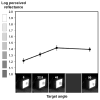To compute lightness, illumination is not estimated, it is held constant
- PMID: 29723008
- PMCID: PMC6062464
- DOI: 10.1037/xhp0000487
To compute lightness, illumination is not estimated, it is held constant
Abstract
The light reaching the eye from a surface does not indicate the black-gray-white shade of a surface (called lightness) because the effects of illumination level are confounded with the reflectance of the surface. Rotating a gray paper relative to a light source alters its luminance (intensity of light reaching the eye) but the lightness of the paper remains relatively constant. Recent publications have argued, as had Helmholtz (1866/1924), that the visual system unconsciously estimates the direction and intensity of the light source. We report experiments in which this theory was pitted against an alternative theory according to which illumination level and surface reflectance are disentangled by comparing only those surfaces that are equally illuminated, in other words, by holding illumination level constant. A 3-dimensional scene was created within which the rotation of a target surface would be expected to become darker gray according to the lighting estimation theory, but lighter gray according to the equi-illumination comparison theory, with results clearly favoring the latter. In a further experiment cues held to indicate light source direction (cast shadows, attached shadows, and glossy highlights) were completely eliminated and yet this had no effect on the results. (PsycINFO Database Record
(c) 2018 APA, all rights reserved).
Figures









References
-
- Adelson EH. Lightness perception and lightness illusions. In: Gazzaniga M, editor. The New Cognitive Neuroscience. 2. Cambridge, MA: MIT Press; 2000. pp. 339–351.
-
- Blakeslee B, McCourt ME. A multiscale spatial filtering account of the White effect, simultaneous brightness contrast and grating induction. Vision Research. 1999;39:4361–4377. - PubMed
-
- Boyaci H, Maloney L, Hersh S. The effect of perceived surface orientation on perceived surface albedo in binocularly viewed scenes. Journal of Vision. 2003;3:541–553. - PubMed
-
- Boyaci H, Doerschner K, Maloney LT. Cues to an Equivalent Lighting Model. Journal of Vision. 2006;6:106–118. - PubMed
-
- Brunswik E. Zur Entwicklung der Albedowahrnehmung (On the development of the perception of albedo) Zeitschrift für Psychologie. 1929;109:40–115.
MeSH terms
Grants and funding
LinkOut - more resources
Full Text Sources
Other Literature Sources
Miscellaneous

